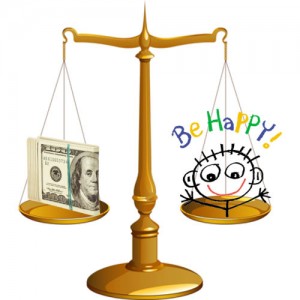For a long time, we knew that there was a happiness plateau, a point where more money basically stopped buying greater satisfaction. Maybe we were wrong. Fittingly or ironically, the dismal science has a lot to say about happiness.
 The classic economic story about money and well-being goes something like this. Money buys happiness, sure, but only up to a point. Once basic needs are taken care of, extra money has diminishing (or non-existent) returns. Perhaps richer people use their money to move to richer areas, where they no longer feel rich. Perhaps relative income — how much you have compared to your friends — is matters much more than absolute income — how much money you have, period.
The classic economic story about money and well-being goes something like this. Money buys happiness, sure, but only up to a point. Once basic needs are taken care of, extra money has diminishing (or non-existent) returns. Perhaps richer people use their money to move to richer areas, where they no longer feel rich. Perhaps relative income — how much you have compared to your friends — is matters much more than absolute income — how much money you have, period.
Economists call it the “Easterlin Paradox.” You call it the “Keeping Up With the Jones’ Principle.”
And a new research paper calls it total bunk. Or, in the economists’ parlance, “based on empirical claims which are simply false.” People with more money have higher reported well-being, they say, all the way up to the top 10 percent of earners. Here are the 6 most interesting observations from “The New Stylized Facts about Income and Subjective Well-Being,” a discussion paper by Daniel W. Sacks, Betsey Stevenson, and Justin Wolfers.
(1) Richer countries are happier. Here’s a simple graph to make a simple point. The researchers plotted 122 countries’ responses to a Gallup World Poll on well-being against each nation’s real GDP per capita (adjusted for purchasing power) and found a strong correlation.
(2) … But every next dollar won’t buy the same amount of happiness. The straight line can be deceptive at first blush. The graph is *not* telling you that every next $1,000 on your paycheck is worth the same gains in satisfaction. Instead, the relationship is logarithmic. That means doubling your income from $1000 to $2000 raises satisfaction by the same amount as doubling your income from $10,000 to $20,000. Not that these findings are as binding as the law of gravity, but this would suggest that, to equal the happiness boost you felt from getting raise from $30,000 to $60,000, another $30,000 wouldn’t do the trick: You would have to double your income again, to $120,000.
(3) Richer countries get happier as they get richer. That first graph answers the question: Do countries with more income report more happiness? The answer seems to be yes. But what about a different question: Do individual countries report more happiness as their incomes rise? Also, yes. The next graph looks the 25 biggest countries in the world and shows the linear relationship between well-being and household income.
(4) There is no “happiness plateau” (or it’s much higher than we thought). Those lines tell us three important things. First, the lines go up. More money, more happiness. Second, the lines go up in parallel, more or less. Across language, culture, religion, ethnic background, the same amount of extra money seems to buy the similar amount of extra happiness. Third, the lines go upin parallel and they don’t flatten out. There is no “Easterlin plateau”, no satiation point, no bright line where money suddenly loses the ability to improve well-being.
(5) Europe’s lesson: A steadily rising level of satisfaction from a steadily rising level of income. The graphs below are a bit more pointilist and messy, but they make a similarly compelling point. The Eurobarometer survey, which has measured life satisfaction across the continent since 1973, clearly shows that in eight of the nine countries for which the researchers have the most data, well-being has increased through time with economic growth. Except for Belgium. You’re weird, Belgium.
(6) The American exception is also a lesson: Income inequality is a tax on happiness.The U.S economy has doubled in size since the early 1970s. But self-reported well-being has declined. Huh?
DEREK THOMPSON, The Atlantic

